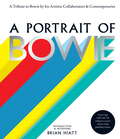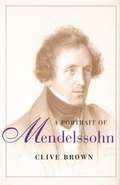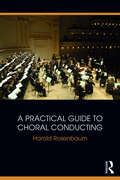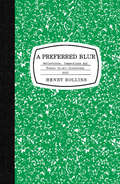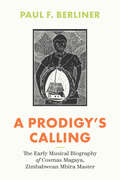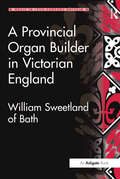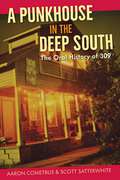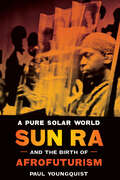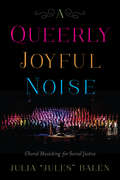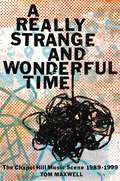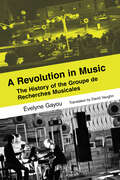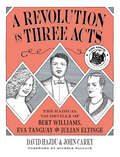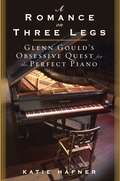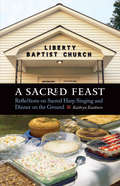- Table View
- List View
A Portrait in Four Movements: The Chicago Symphony under Barenboim, Boulez, Haitink, and Muti
by Andrew Patner“Playing in an orchestra in an intelligent way is the best school for democracy.”—Daniel Barenboim The Chicago Symphony Orchestra has been led by a storied group of conductors. And from 1994 to 2015, through the best work of Daniel Barenboim, Pierre Boulez, Bernard Haitink, and Riccardo Muti, Andrew Patner was right there. As music critic for the Chicago Sun-Times and WFMT radio, Patner was able to trace the arc of the CSO’s changing repertories, all while cultivating a deep rapport with its four principal conductors. This book assembles Patner’s reviews of the concerts given by the CSO during this time, as well as transcripts of his remarkable radio interviews with these colossal figures. These pages hold tidbits for the curious, such as Patner’s “driving survey” that playfully ranks the Maestri he knew on a scale of “total comfort” to “fright level five,” and the observation that Muti appears to be a southpaw on the baseball field. Moving easily between registers, they also open revealing windows onto the sometimes difficult pasts that brought these conductors to music in the first place, including Boulez’s and Haitink’s heartbreaking experiences of Nazi occupation in their native countries as children. Throughout, these reviews and interviews are threaded together with insights about the power of music and the techniques behind it—from the conductors’ varied approaches to research, preparing scores, and interacting with other musicians, to how the sound and personality of the orchestra evolved over time, to the ways that we can all learn to listen better and hear more in the music we love. Featuring a foreword by fellow critic Alex Ross on the ethos and humor that informed Patner’s writing, as well as an introduction and extensive historical commentary by musicologist Douglas W. Shadle, this book offers a rich portrait of the musical life of Chicago through the eyes and ears of one of its most beloved critics.
A Portrait of Bowie: A tribute to Bowie by his artistic collaborators and contemporaries
by Brian HiattA strikingly unique tribute to David Bowie, comprising a collection of 40 visual portraits of the icon throughout his career, and text tributes by his artistic collaborators and contemporaries.
A Portrait of Bowie: A tribute to Bowie by his artistic collaborators and contemporaries
by Brian HiattHIS LIFE WAS A WORK OF ARTNow, artists and musicians who worked with David Bowie during his lifetime - or who were his contemporaries - pay tribute to the icon through their own words on what it was like to work in collaboration with a man whose fluid artistic genius repeatedly broke boundaries, right up until his death. Alongside these text tributes are 40 stunning illustrative and photographic portraits of Bowie throughout his career. The contributing artists and photographers include (alphabetically): Edward Bell, Derek Boshier, Anton Corbijn, Kevin Cummins, Chuck Connelly, Chalkie Davies, Stephen Finer, Greg Gorman, Derry Moore, Terry O'Neill, Mick Rock, Masayoshi Sukita, George Underwood, Justin de Villeneuve and more. Alongside these remarkable portraits are insightful, personal written pieces by his contemporaries, and musicians and artists who worked closely with Bowie, including Zachary Alford, Carlos Alomar, Toni Basil, Gail Ann Dorsey, Mike Garson, Dana Gillespie, Debbie Harry and Chris Stein, Cyndi Lauper, and Nile Rodgers, among others. The book is curated by Brian Hiatt, of Rolling Stone magazine, as General Editor.** Newly revised and improved ebook edition, optimized for both small- and large-screen devices **
A Portrait of Mendelssohn
by Clive BrownClive Brown draws a different picture of Felix Mendelssohn's personality and work.
A Power Stronger Than Itself: The AACM and American Experimental Music
by George E. LewisFounded in 1965 and still active today, the Association for the Advancement of Creative Musicians (AACM) is an American institution with an international reputation. From its working-class roots on the South Side of Chicago, the AACM went on to forge an extensive legacy of cultural and social experimentation, crossing both musical and racial boundaries. The success of individual members and ensembles such as Muhal Richard Abrams, the Art Ensemble of Chicago, and Anthony Braxton has been matched by the enormous influence of the collective itself in inspiring a generation of musical experimentalists. George E. Lewis, who joined the collective as a teenager in 1971, establishes the full importance and vitality of the AACM with this communal history, written with a symphonic sweep that draws on a cross-generational chorus of voices and a rich collection of rare images. Faced with shrinking economic opportunities in Chicago and a segregated music industry, the original members of the AACM found inspiration in the civil rights movement's call for change through self-determination and collective action. These musicians pooled their individual strengths in a new organization powerfully committed to a forward-thinking approach to musical creation and performance. Evolving a range of experimental methods, from invented instruments and unusual musical scores to improvisation and the early use of computers, the AACM challenged the borders separating classical music and jazz.
A Power Stronger Than Itself: The AACM and American Experimental Music (The\kenneth Nebenzahl, Jr. , Lectures In The History Of Cartography Ser.)
by George E. LewisFounded in 1965 and still active today, the Association for the Advancement of Creative Musicians (AACM) is an American institution with an international reputation. George E. Lewis, who joined the collective as a teenager in 1971, establishes the full importance and vitality of the AACM with this communal history, written with a symphonic sweep that draws on a cross-generational chorus of voices and a rich collection of rare images. Moving from Chicago to New York to Paris, and from founding member Steve McCall’s kitchen table to Carnegie Hall, A Power Stronger Than Itself uncovers a vibrant, multicultural universe and brings to light a major piece of the history of avant-garde music and art.
A Practical Approach to the Study of Form in Music
by Peter Spencer Peter M. TemkoLearning music's organizing principles . . . Approaching the study of form as an exercise in perceiving the interaction of a number of discrete musical events, Spencer and Temko's book embodies much more than a search for visual clues. Students of form develop perceptual tools that allow them to proceed from the aural experience to an understanding of the arch-principles upon which music is organized. The authors hold that the organizing principles of a given piece of music may be gleaned from studying: the internal attributes that give a section its specific identity; the functional relations between sections; the ordering of those sections.
A Practical Guide to Choral Conducting
by Harold RosenbaumRooted in the experience of a professional choral conductor, this book provides a guide to practical issues facing conductors of choral ensembles at all levels, from youth choruses to university ensembles, church and community choirs, and professional vocal groups. Paired with the discussion of practical challenges is a discussion of over fifty key works from the choral literature, with performance suggestions to aid the choral conductor in directing each piece. Dealing with often-overlooked yet vital considerations such as how to work with composers, recording, concert halls, and choral tours, A Practical Guide to Choral Conducting offers a valuable resource for both emerging choral conductors and students of choral conducting at the undergraduate and graduate levels.
A Preferred Blur
by Henry Rollins2007 was a very busy year for Henry Rollins. He traveled to Iran, Syria, Lebanon, and Pakistan, where he was staying when Prime Minister Benazir Bhutto was assassinated. While traveling, Rollins performed numerous spoken word shows and worked on films, his IFC television show, and Harmony in My Head, his popular weekly radio show. In short, a quintessentially Rollins-ian year: sleepless, nonstop, and highly productive. A Preferred Blur contains stories written in the form of journal entries from Rollins' travels throughout the year. As in his other travel-related books and journals, Rollins - Detail magazine's 1994 Man of the Year - writes not only about his own life and work, but of music, current affairs, and the world around him with humor, insight, and brutal honesty.
A Prodigy's Calling: The Early Musical Biography of Cosmas Magaya, Zimbabwean Mbira Master (Chicago Studies in Ethnomusicology)
by Paul F. BerlinerThe coming-of-age story of a master musician in mid-twentieth century colonial Rhodesia as he learns his community’s most cherished art, all while navigating profound social transformation. Ethnomusicologist Paul F. Berliner has been studying Zimbabwean mbira for more than fifty years. When he first arrived in what was then Rhodesia after the nation declared independence from the United Kingdom, he met Cosmas Magaya, a mbira player who would become his teacher and lifelong collaborator. A Prodigy’s Calling chronicles the early years of Magaya’s life, documenting the master mbira player’s journey from child prodigy to established expert. As a child, Magaya was immersed in mbira music through his father’s work as a healer and spirit medium. As Magaya grew, so too did his world; his performances extended beyond the family compound as his skill and knowledge increased, bringing him into contact with a society fraught with decolonial conflict. Following Magaya’s childhood, readers will learn how his upbringing guided his journey through the community’s social networks and how his early sensibilities, proclivities, and talents shaped his development. At the same time, his deepening engagement with music and the ancestors was affected by overlapping tensions between Shona cosmology and Christian ideology, rural and urban lifestyles, and the escalating African nationalist struggle and the white supremacist state. While Magaya’s story reflects profound social changes in the nation, it is also a story of musical apprenticeship. Readers following Magaya’s discovery of ever finer details in the music’s richly layered patterns will enhance their ability to hear mbira music’s forms, variations, and sonic qualities. Linocut illustrations by South African artist Lucas Bambo bring the narrative to life, and Berliner’s spirited storytelling is accompanied by QR codes that take readers directly to recordings of music as Magaya learns it. Appendices for musicians interested in learning or improving their mbira playing complement the story of Magaya’s early life. Inviting the reader into the very tradition it recounts, the book offers intimate insights into the relationships among music, Shona cosmology, and colonial politics in everyday life.
A Provincial Organ Builder in Victorian England: William Sweetland of Bath (Music in Nineteenth-Century Britain)
by Gordon D.W. CurtisWilliam Sweetland was a Bath organ builder who flourished from c.1847 to 1902 during which time he built about 300 organs, mostly for churches and chapels in Somerset, Gloucestershire and Wiltshire, but also for locations scattered south of a line from the Wirral to the Wash. Gordon Curtis places this work of a provincial organ builder in the wider context of English musical life in the latter half of the nineteenth century. An introductory chapter reviews the provincial musical scene and sets the organ in the context of religious worship, public concerts and domestic music-making. The book relates the biographical details of Sweetland's family and business history using material obtained from public and family records. Curtis surveys Sweetland's organ- building work in general and some of his most important organs in detail, with patents and other inventions explored. The musical repertoire of the provinces, particularly with regard to organ recitals, is discussed, as well as noting Sweetland's acquaintances, other organ builders, architects and artists. Part II of the book consists of a Gazetteer of all known organs by Sweetland organized by counties. Each entry contains a short history of the instrument and its present condition. Since there is no definitive published list of his work, and as all the office records were lost in a fire many years ago, this will be the nearest approach to a comprehensive list for this builder.
A Punkhouse in the Deep South: The Oral History of 309
by Aaron Cometbus Scott SatterwhiteRadical subcultures in an unlikely place Told in personal interviews, this is the collective story of a punk community in an unlikely town and region, a hub of radical counterculture that drew artists and musicians from throughout the conservative South and earned national renown. The house at 309 6th Avenue has long been a crossroads for punk rock, activism, veganism, and queer culture in Pensacola, a quiet Gulf Coast city at the border of Florida and Alabama. In this book, residents of 309 narrate the colorful and often comical details of communal life in the crowded and dilapidated house over its 30-year existence. Terry Johnson, Ryan “Rymodee” Modee, Gloria Diaz, Skott Cowgill, and others tell of playing in bands including This Bike Is a Pipe Bomb, operating local businesses such as End of the Line Cafe, forming feminist support groups, and creating zines and art. Each voice adds to the picture of a lively community that worked together to provide for their own needs while making a positive, lasting impact on their surrounding area. Together, these participants show that punk is more than music and teenage rebellion. It is about alternatives to standard narratives of living, acceptance for the marginalized in a rapidly changing world, and building a sense of family from the ground up. Including photos by Cynthia Connolly and Mike Brodie, A Punkhouse in the Deep South illuminates many individual lives and creative endeavors that found a home and thrived in one of the oldest continuously inhabited punkhouses in the United States.
A Pure Solar World: Sun Ra and the Birth of Afrofuturism (Discovering America)
by Paul YoungquistSun Ra said he came from Saturn. Known on earth for his inventive music and extravagant stage shows, he pioneered free-form improvisation in an ensemble setting with the devoted band he called the “Arkestra.” Sun Ra took jazz from the inner city to outer space, infusing traditional swing with far-out harmonies, rhythms, and sounds. Described as the father of Afrofuturism, Sun Ra created “space music” as a means of building a better future for American blacks here on earth. A Pure Solar World: Sun Ra and the Birth of Afrofuturism offers a spirited introduction to the life and work of this legendary but underappreciated musician, composer, and poet. Paul Youngquist explores and assesses Sun Ra’s wide-ranging creative output—music, public preaching, graphic design, film and stage performance, and poetry—and connects his diverse undertakings to the culture and politics of his times, including the space race, the rise of technocracy, the civil rights movement, and even space-age bachelor-pad music. By thoroughly examining the astro-black mythology that Sun Ra espoused, Youngquist masterfully demonstrates that he offered both a holistic response to a planet desperately in need of new visions and vibrations and a new kind of political activism that used popular culture to advance social change. In a nation obsessed with space and confused about race, Sun Ra aimed not just at assimilation for the socially disfranchised but even more at a wholesale transformation of American society and a more creative, egalitarian world.
A Pure Solar World: Sun Ra and the Birth of Afrofuturism (Discovering America)
by Paul Youngquist&“Youngquist brings considerable skills to the life and work of the legendary but underappreciated and often misunderstood composer, keyboardist, and poet.&” —PopMatters Sun Ra said he came from Saturn. Known on earth for his inventive music and extravagant stage shows, he pioneered free-form improvisation in an ensemble setting with the devoted band he called the &“Arkestra.&” Sun Ra took jazz from the inner city to outer space, infusing traditional swing with far-out harmonies, rhythms, and sounds. Described as the father of Afrofuturism, Sun Ra created &“space music&” as a means of building a better future for American blacks here on earth. In A Pure Solar World: Sun Ra and the Birth of Afrofuturism, Paul Youngquist explores and assesses Sun Ra&’s wide-ranging creative output—music, public preaching, graphic design, film and stage performance, and poetry—and connects his diverse undertakings to the culture and politics of his times, including the space race, the rise of technocracy, the civil rights movement, and even space-age bachelor-pad music. By thoroughly examining the astro-black mythology that Sun Ra espoused, Youngquist masterfully demonstrates that he offered both a holistic response to a planet desperately in need of new visions and vibrations and a new kind of political activism that used popular culture to advance social change. In a nation obsessed with space and confused about race, Sun Ra aimed not just at assimilation for the socially disfranchised but even more at a wholesale transformation of American society and a more creative, egalitarian world. &“A welcome invitation to the spaceways.&” —Jazzwise
A Queerly Joyful Noise: Choral Musicking for Social Justice
by Julia Jules" BalénA Queerly Joyful Noise examines how choral singing can be both personally transformative and politically impactful. As they blend their different voices to create something beautiful, LGBTIQ singers stand together and make themselves heard. Comparing queer choral performances to the uses of group singing within the civil rights and labor movements, Julia “Jules” Balén maps the relationship between different forms of oppression and strategic musical forms of resistance. She also explores the potential this queer communal space creates for mobilizing progressive social action. A proud member of numerous queer choruses, Balén draws from years of firsthand observations, archival research, and extensive interviews to reveal how queer chorus members feel shared vulnerability, collective strength, and even moments of ecstasy when performing. A Queerly Joyful Noise serves as a testament to the power of music, intimately depicting how participation in a queer chorus is more than a pastime, but a meaningful form of protest through celebration.
A Question of Balance: Charles Seeger's Philosophy of Music
by Taylor Aitken GreerOne of this century's most influential musical intellects takes center stage in Taylor Greer's meticulously wrought study of Charles Seeger (1886-1979). Seeger left an indelible mark in the fields of musicology, music criticism, ethnomusicology, and avant-garde musical composition, but until now there has been no extended appreciation and critique of Seeger's work as a whole, nor has an accessible guide to his texts been available.Exploring the entire corpus of Charles Seeger's writing, A Question of Balance highlights the work of those persons who most influenced him, especially Henri Bergson, Bertrand Russell, and Ralph Perry. Invited to inaugurate the music department at the University of California's Berkeley campus in 1912, Seeger became keenly aware of his deficiencies in general education and put himself on a rigorous regimen of intellectual development that included studying history, anthropology, political theory, and philosophy. For the remainder of his life his ideas about music heavily influenced the development of ethnomusicology and systematic musicology.Charles Seeger is perhaps best known as the father of the folk singers Pete, Mike, and Peggy Seeger and as the husband of the innovative American composer Ruth Crawford. This book makes clear that Seeger was an extremely important thinker and educator in his own right. Seeger's intellectual curiosity was as eclectic as it was enthusiastic, and Greer skillfully weaves together the connections Seeger made between music, the humanities, and the sciences. The result is a luminous tapestry depicting Seeger's ideal schemes of musicology. At the same time it reflects the turbulence and vitality in American musical life during the early decades of the century.
A Really Strange and Wonderful Time: The Chapel Hill Music Scene: 1989-1999
by Tom MaxwellTHE FIRST BIOGRAPHY OF THE THRIVING AND INFLUENTIAL ROCK SCENE IN CHAPEL HILL, WHICH GAVE THE WORLD ARTISTS LIKE BEN FOLDS FIVE, SUPERCHUNK, AND SQUIRREL NUT ZIPPERS North Carolina has always produced extraordinary music of every description. But the indie rock boom of the late 1980s and early &’90s brought the state most fully into the public consciousness, while the subsequent post-grunge free-for-all bestowed its greatest commercial successes. In addition to the creation of legacy label Merge Records and a slate of excellent indie bands like Superchunk, Archers of Loaf, and Polvo, this was the decade when other North Carolina artists broke Billboard &’s Top 200 and sold millions of records—several million of which were issued by another indie label based in Carrboro, Chapel Hill&’s smaller next-door neighbor. It&’s time to take a closer look at exactly what happened.A Really Strange and Wonderful Time features a representative cross section of what was being created in and around Chapel Hill between 1989 and 1999. In addition to the aforementioned indie bands, it documents—through firsthand accounts—other local notables like Ben Folds Five, Dillon Fence, Flat Duo Jets, Small, Southern Culture on the Skids, The Veldt, and Whiskeytown. At the same time, it describes the nurturing infrastructure which engendered and encouraged this marvelous diversity. In essence, A Really Strange and Wonderful Time is proof of the genius of community.
A Respectable Spell: Transformations of Samba in Rio de Janeiro
by Carlos SandroniA landmark in Brazilian music scholarship, A Respectable Spell introduces English-speaking readers to the rich history of samba from its nineteenth century origins to its emergence as a distinctive genre in the 1930s. Merging storytelling with theory, Carlos Sandroni profiles performers, composers, and others while analyzing the complex ideologies their music can communicate in their lyrics and rhythms, and how the meaning of songs and musical genres can vary depending on social and historical context. He also delves into lundu, modinha, maxixe, and many other genres of Brazilian music; presents the little-heard voices and perspectives of marginalized Brazilians like the African-descended sambistas; and presents a study in step with the types of decolonial approaches to ethnomusicology that have since emerged, treating the people being studied not only as makers of music but also of knowledge. Incisive and comprehensive, A Respectable Spell tells the compelling story of an iconic Brazilian musical genre.
A Revolution in Music: The History of the Groupe de Recherches Musicales
by Évelyne GayouEstablished in the 1950s by musician and engineer Pierre Schaeffer, the Groupe de Recherches Musicales would become the nerve center for avant-garde artists experimenting with sound and acoustics, as well as the birthplace of a genre of music-making enabled by new recording technologies and sound pioneers: musique concrète. Évelyne Gayou—herself a researcher, composer, and producer at the GRM—tells the history of the storied institution through the people, works, technologies, and research developed there. Placing musique concrète within a broad historical context extending from the early twentieth-century avant-garde's experiments with noise to the development of techniques in sound recording (at the Studio d'Essai in the 1940s) and later in sound synthesis, Gayou shows how recording technology made it possible for composers to not only create music from sounds in the world around them but also create acousmatic music—novel sounds without a visible connection to their source. Available in English translation for the first time, this updated edition will be an important resource for readers interested in the pioneering works and techniques of Schaeffer and his contemporaries, as well as their influence on the makers of new music and the contemporary avant-garde.
A Revolution in Three Acts: The Radical Vaudeville of Bert Williams, Eva Tanguay, and Julian Eltinge
by David Hajdu John CareyBert Williams—a Black man forced to perform in blackface who challenged the stereotypes of minstrelsy. Eva Tanguay—an entertainer with the signature song “I Don’t Care” who flouted the rules of propriety to redefine womanhood for the modern age. Julian Eltinge—a female impersonator who entranced and unnerved audiences by embodying the feminine ideal Tanguay rejected. At the turn of the twentieth century, they became three of the most provocative and popular performers in vaudeville, the form in which American mass entertainment first took shape.A Revolution in Three Acts explores how these vaudeville stars defied the standards of their time to change how their audiences thought about what it meant to be American, to be Black, to be a woman or a man. The writer David Hajdu and the artist John Carey collaborate in this work of graphic nonfiction, crafting powerful portrayals of Williams, Tanguay, and Eltinge to show how they transformed American culture. Hand-drawn images give vivid visual form to the lives and work of the book’s subjects and their world.This book is at once a deft telling of three intricately entwined stories, a lush evocation of a performance milieu with unabashed entertainment value, and an eye-opening account of a key moment in American cultural history with striking parallels to present-day questions of race, gender, and sexual identity.
A Riot of Our Own
by Johnny Green Garry Barker'Hugely enjoyable ... Green's great achievement is to recapture exactly how those moments felt, but remain sufficiently detached about the whole thing to render the experience honestly' MOJOJohnny Green first met the Clash in 1977. A RIOT OF OUR OWN is his tale of three delirious years of rock 'n' roll madness as confidant and road manager of the Clash, from the early punk days to LONDON CALLING and touring America. Ray Lowry accompanied the band as official 'war artist' on the second American tour and designed the London Calling album cover. Together, in words and pictures, Green and Lowry give the definitive, inside story on one of the most magnificent rock 'n' roll bands ever.
A Riot of Our Own: Night And Day On The Road With The Clash
by Johnny Green Garry Barker'Hugely enjoyable ... Green's great achievement is to recapture exactly how those moments felt, but remain sufficiently detached about the whole thing to render the experience honestly' MOJOJohnny Green first met the Clash in 1977. A RIOT OF OUR OWN is his tale of three delirious years of rock 'n' roll madness as confidant and road manager of the Clash, from the early punk days to LONDON CALLING and touring America. Ray Lowry accompanied the band as official 'war artist' on the second American tour and designed the London Calling album cover. Together, in words and pictures, Green and Lowry give the definitive, inside story on one of the most magnificent rock 'n' roll bands ever.
A Romance on Three Legs: Glenn Gould's Obsessive Quest for the Perfect Piano
by Katie HafnerThe story of a legendary pianist's obsession with the unique, temperamental instrument he loved. Important figures in Gould's life are introduced including his nearly blind tuner.
A Sacred Feast: Reflections on Sacred Harp Singing and Dinner on the Ground (At Table)
by Kathryn EastburnSome have called Sacred Harp singing America&’s earliest music. This powerful nondenominational religious singing, part of a deeply held Southern culture, has spread throughout the nation over the past two centuries. In A Sacred Feast, Kathryn Eastburn journeys into the community of Sacred Harp singers across the country and introduces readers to the curious glories of a tradition that is practiced today just as it was two hundred years ago. Each of the book&’s chapters visits a different region and features recipes from the accompanying culinary tradition—dinner on the ground, a hearty noontime feast. From oven-cooked pulled pork barbeque to Dollar Store cornbread dressing to red velvet cake, these recipes tell a story of nourishing the body, the soul, and the voice. The Sacred Harp&’s deeply moving sound and spirit resonate through these pages, captured at conventions in Alabama, Kentucky, Texas, Colorado, and Washington, conveyed in portraits of singers, and celebrated in the sights, sounds, smells, and tastes of all-day singing and dinner on the ground echoing through generations and centuries.
A Schoenberg Reader: Documents of a Life
by Joseph Henry AunerArnold Schoenberg and his music have been objects of celebration, controversy, and vilification for more than a century, from the time of his first performances to the present day. Not surprisingly, in accounts of his life and works by both his champions and his critics the adjective Schoenbergian has come to mean so many things as to be almost meaningless.

